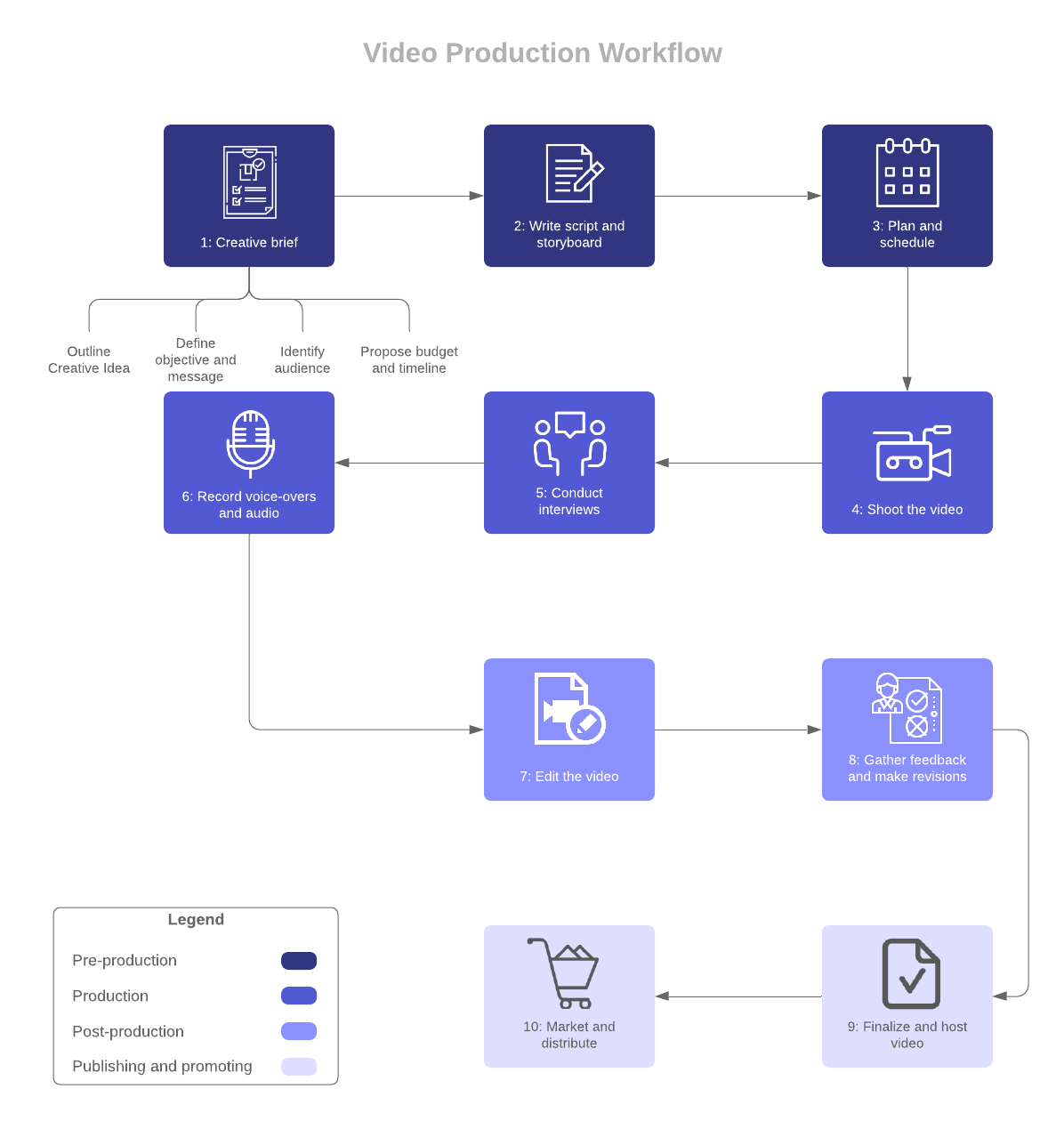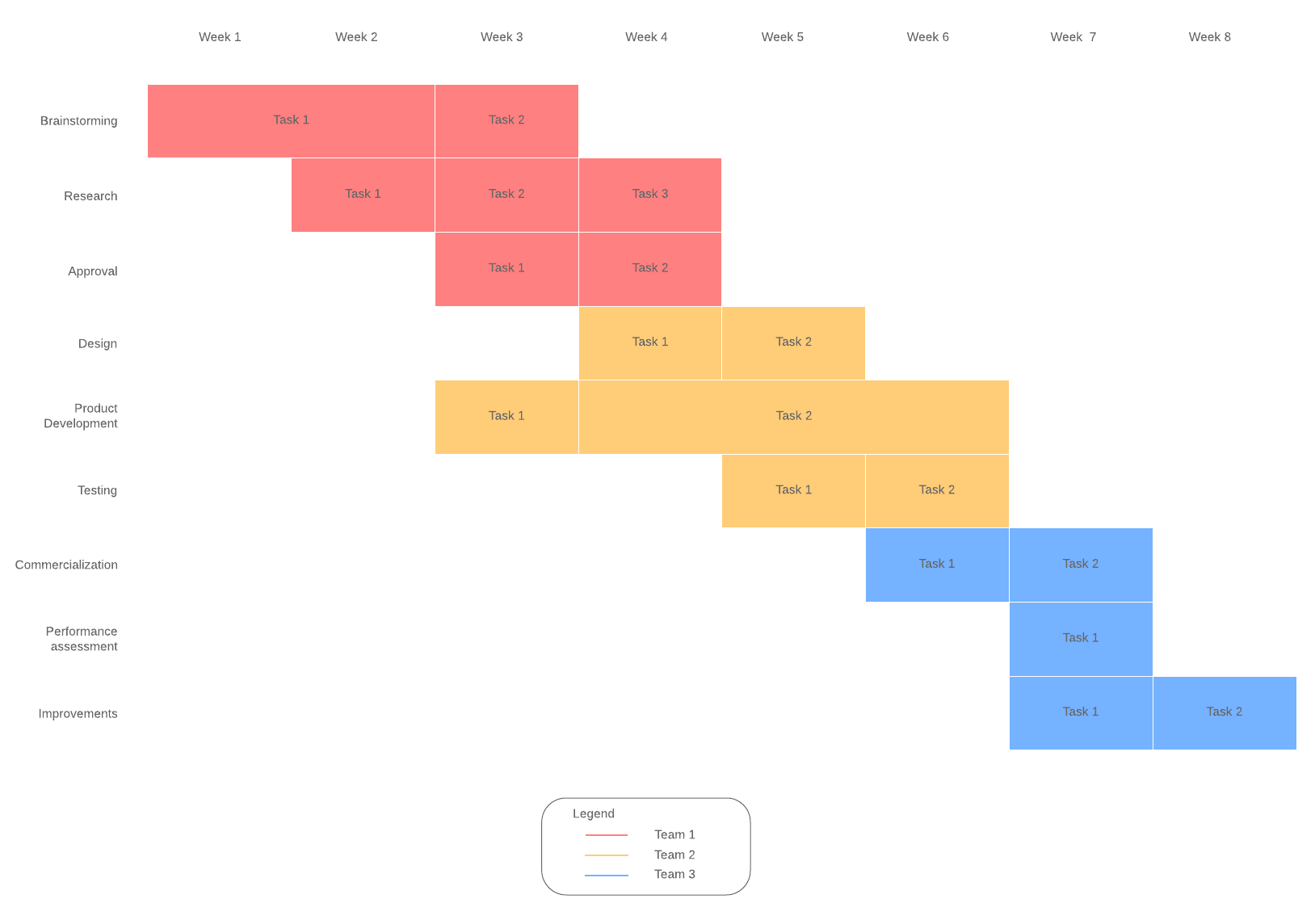
How to Develop a Successful Video Production Workflow
Lucid Content
Reading time: about 7 min
Topics:
A staggering 87% of marketers use video as a marketing tool. If you’re one of them, then you know that video production is about more than just pointing a camera and shouting “Action!”
Managing video production requires input from many different teams, creatives, and contributors—and that can get messy fast. To stay on top of everything (and deliver great content on budget and on deadline), you need a strong video production workflow.
Whether you’re a production agency juggling multiple video projects or a company looking to produce their own content in-house, use the following tips to develop a streamlined process from pre-production to “That’s a wrap!” and everything in between.

Why you need a video production workflow
As with any project, having a workflow can help you manage resources effectively, invest your time efficiently, and keep different teams and individual contributors on task—even if you’re working remotely.
In a business where ROI is crucial, a clear video production workflow can iron out inefficiencies and prevent costly delays and miscommunication. In other words, the smoother the process, the more money in the bank.
Although video production has become more affordable and achievable for companies, it is not a simple process. There are multiple stages of production, each with laundry lists of to-dos, and contributors and stakeholders with varying degrees of input in the process.
Without a clear workflow, teams and individuals will struggle to understand their roles and responsibilities, tasks will fall through the cracks, budgets and deadlines will be blown, and the final product will suffer.
Nailing each stage of video production
There are four main stages of video production. Each stage requires careful management and a clear workflow.
Pre-production
Pre-production is a critical stage. This is when you lay the foundation for your video. How well you prepare here will have a direct impact on the quality of the production.
Pre-production involves all the tasks and prep work required to get your video into production, including developing your idea, writing a script, and building a team. Here are a few of the steps and requirements you’ll need to cover in your video production pipeline:
Treatment or creative brief: A video treatment (sometimes called a creative brief) is a summary of your project. It’s the place where you will:
- Outline the creative idea for the content.
- Define the video’s core objective and message.
- Identify the target audience.
- Propose a budget and timeline for the production.
The treatment is often used to pitch the concept to decision-makers. However, it is also an important guiding document that can help you make strategic decisions throughout the production process to ensure the project remains “on brief” and aligns with your overall goals.
Script and storyboard: Once you’ve clarified the treatment, you and your team will draft a script and create a storyboard.
A storyboard is a sequence of drawings illustrating the shots planned for the video. The point is to help the creative team visualize each shot and scene. A storyboard clarifies the narrative and helps the film crew understand the vision for the video.

Plan and schedule: Finally, you’ll need a plan and a schedule mapped out to ensure all your ducks are in a row.

This process involves building a team (e.g., writers, director, video editors, sound engineers, etc.), prepping or scouting the shooting location, casting, licensing and permissions, and outlining your contingency plans.
Pre-production is an important part of the video production pipeline. Mapping out these steps in a clear workflow will help you build a strong foundation for your content.
Production
Production is where all your plans come together to bring your video to life.
This stage includes:
- The shoot
- Set up, lighting, sound, filming, logging shots
- Capturing b-roll
- Conducting interviews
- Recording voice-over audio
For production to go smoothly, you’ll need both a good workflow and a good project manager to make sure each creative element is captured and ready for post-production.
Post-production
Post-production is often the unsung hero of video production. This is the stage where all the film and sound has been shot and recorded in its raw form and is ready for an editor’s magic touch.
During post-production, the video will go through an editing process (which includes adding graphics or visuals, sound mixing, and adding voice-over if needed) and one or more rounds of feedback and revisions before final sign-off and approval.
A high-level workflow for each of these steps can help teams communicate effectively and stay on the same page as they provide feedback and move towards the final deliverable.
Publishing and promotion
The last stage is to publish and promote video content. Exactly how you do this will depend on your specific strategy and goals for the video. However, this milestone typically includes the following steps:
- Finalize, format, and host the video in your desired location.
- Track analytics to measure success and ROI.
- Market and distribute.
How you promote your video will be based on your outlined strategy. Here are a few ways you could promote and distribute your content:
- Share on social media.
- Distribute through paid ads.
- Use PR to spread the word at different outlets.
- Incorporate video into your marketing (email, onsite, etc.).
With your strategy as a guide, you can build a video production workflow that outlines when and where to distribute your video and assign who is responsible for each task.
Building an effective video production pipeline
Now that you understand the steps involved in the production process, you can develop a workflow that makes sense for you and your team. Use the following tips and best practices to create a successful video production workflow.
1. Create repeatable processes
The more you can systemize your processes the better. Look for opportunities to standardize and automate processes.
Having repeatable, standard processes throughout each stage of the production pipeline not only increases efficiency, helping you meet deadlines and budget constraints, but it also keeps everyone on the same page.
2. Assign a point person to manage it
Projects quickly get derailed if there isn’t a project owner to lead it. Make sure you have a video production manager who can act as point person for each stage of the process.
They should be able to delegate and communicate effectively across teams to keep the project on track. This is especially important if you’re working with contractors, freelancers, or distributed teams who are juggling their own schedules, timelines, and objectives.
A designated point person can make sure each contributor knows what is expected of them, when they need to deliver, and can guide them to any resources or contacts they may need.

3. Host info in a central database
Video production has so many moving parts to juggle that it’s easy for something to fall through the cracks. But keeping information, resources, and documentation in one central place can help reduce miscommunication.
Consolidate data where possible. Keep files, folders, timelines, and workflows in a central database where all relevant parties can access the info they need when they need it.
Challenges
There are a couple of big challenges to keep in mind when designing an effective workflow.
One challenge is making sure you organize and incorporate enough information for team members and contributors to understand the process and their responsibilities without micromanaging or creating information overload.
Another challenge is building a workflow that is easy to access, share, and update—even when teams are distributed in different locations.
That’s where Lucidchart comes in.
Using Lucidchart to build your video production workflow
Lucidchart’s visual diagramming platform keeps all your data in one easy-to-share location so project managers, freelancers, and directors and actors are all on the same page.
Eliminate miscommunication and costly delays in production with clear video production pipelines, workflows, and calendars built right on the Lucidchart platform.
Get started with ready-made templates and an extensive shape library. Rich features like swimlanes, data linking, and conditional formatting make it easy to track tasks and assigned roles and monitor upcoming deadlines.
Video production can be a monster project, but with careful planning, strong management, and a clear workflow, you can create high-quality content every time.
Manage video production in LucidchartAbout Lucidchart
Lucidchart, a cloud-based intelligent diagramming application, is a core component of Lucid Software's Visual Collaboration Suite. This intuitive, cloud-based solution empowers teams to collaborate in real-time to build flowcharts, mockups, UML diagrams, customer journey maps, and more. Lucidchart propels teams forward to build the future faster. Lucid is proud to serve top businesses around the world, including customers such as Google, GE, and NBC Universal, and 99% of the Fortune 500. Lucid partners with industry leaders, including Google, Atlassian, and Microsoft. Since its founding, Lucid has received numerous awards for its products, business, and workplace culture. For more information, visit lucidchart.com.
Related articles
How Lucidites Use Lucidchart: Diagrams for Marketing
At Lucid Software, we truly believe that our products will make work better for you and your colleagues. Why? Because we use them ourselves. See how Lucid Software employees (known as Lucidities) use Lucidchart and how our diagramming software could help employees in various roles at your company. First up: Lucidchart’s marketing team.
The 4 phases of the project management life cycle
Learn about the 4 phases of the project management life cycle. Whether you’re working on a small project or a large, multi-departmental initiative, you can apply our tips to successfully take your projects from initiation to close.
